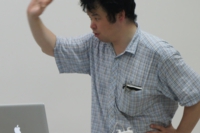
Overture of FSPIP2013
In order to prepare our conference, make it better as far as possible, we arrange several series of workshops in various cities in Japan.
The first one will be held on University of Tokyo.
This is a starting point of our conference which will be held on July 2013.
Date: 2012.06.19
Venue: University of Tokyo, Faculty of Science Bldg. I, Room 445
Program
Time table has been changed.
09:45- Opening remarks Masayuki Ohzeki
10:00- Invited Talk given by Muneki Yasuda (Tohoku University)
"Overview of inverse Ising problem and techniques for it"
Abstract
Recently, techniques based on mean-field methods for inverse Ising problems have been developed in the statistical mechanical field.
In inverse Ising problem, values of parameters, physical fields and interactions, of Ising models are unknown, but we know values of physical quantities, local magnetizations and susceptibilities, from given observed data sets.
Under such a situation, we should infer values of parameters using given values of physical quantities.
This is the inverse Ising problem.
On the other hand, the inverse Ising problems are known as Boltzmann machine learnings in the statistical machine learning area, and techniques for them have been developed independently from the statistical mechanical field.
In the first part of this talk, I will briefly explain a framework of the inverse Ising problem.
After that, I will discuss about some techniques for the inverse Ising problems in the latter part of this talk.
13:30- Invited Talk given by Tomoyuki Obuchi (Osaka University)
"Random coding and replica method"
Abstract
For storing or transmitting data expressed in a sequence of bits, direct use of the raw data is usually inconvenient on many points such as security, stability, and memory capacity. “Coding” is a general framework to avoid such inconveniences by mapping the raw sequence of bits to another sequence. Actual implementations of coding have vast amounts of variants, each of which has merits and demerits depending on situations, and exploration of good-coding methods is an important theme in information theory. Under such circumstance, some spectacular progresses are recently obtained by statistical mechanical analyses of several coding methods. In this talk, however, such spectacular results are not focused, and instead we focus on the methodology of statistical mechanics to obtain those results. Especially, the importance of replica method is emphasized. After that, we introduce the most primitive type of random code and its simple extension with a hierarchical structure. The replica method enables us to analyze the performance. The result will be presented with the implication.
15:00- Invited Talk given by Kazumasa A Takeuchi (University of Tokyo)
"Liquid-crystal turbulence unveils universality out of equilibrium"
Abstract
What happens if ferromagnetic spins are endowed with flow? Nematic liquid crystal is one such realization, which moreover allows direct observation of spin orientation and vortices. Here I show that turbulent vortices in electrically driven nematics evidence a number of universal scaling laws out of equilibrium, connecting critical behavior and interface dynamics of the turbulent nematics to a number of seemingly unrelated problems, such as percolation, disordered system and random matrix theory.
Prologue Series I of FSPIP2013
Starting from the overture, to keep in touch with each other of researchers in our realms, we continue to hold workshops in various cities in Japan.
Date: 2012.08.20
Venue: University of Tokyo, Institute of Industrial Science, Room As301-302
Program
09:45- Opening remarks Masayuki Ohzeki
10:00- Invited Talk given by Takahiro Sagawa (Kyoto University)
"How to Reconcile Maxwell's Demon with the Second Law?"
Abstract
Ever since the nineteenth century, Maxwell's demon has attracted a lot of attentions concerning the foundation of the second law of thermodynamics [1]. Recently, the demon has been experimentally realized [2]. The demon can adiabatically decrease the entropy of thermodynamic systems by feedback control, which seems to be a violation of the second law. A crucial question is: What reconciles the demon with the second law? In this talk, I will answer this question on the basis of our recent theoretical works [3-5]. First, I will introduce the basic concepts in information theory and nonequilibrium thermodynamics. Second, I will show that, on the basis of generalized Jarzynski equalities, the positive entropy production during measurement compensates for the negative entropy production during feedback control. Third, I will briefly review the history of Maxwell's demon, and clarify the consistency between our results and previous researches. Our results constitute the second law of "information thermodynamics," in which thermodynamic quantities and information contents are treated on an equal footing.
[1] "Maxwell's demon 2: Entropy, Classical and Quantum Information, Computing," H. S. Leff and A. F. Rex (eds.), (Princeton University Press, New Jersey, 2003).
[2] S. Toyabe, T. Sagawa, M. Ueda, E. Muneyuki, and M. Sano, Nature Physics 6, 988-992 (2010).
[3] T. Sagawa and M. Ueda, Phys. Rev. Lett. 102, 250602 (2009).
[4] T. Sagawa and M. Ueda, Phys. Rev. Lett. 104, 198904 (2010).
[5] T. Sagawa and M. Ueda, arXiv:1206.2479 (2012).
13:30- Invited Talk given by Yuki Sughiyama (University of Tokyo)
"Nonequilibrium Work Relation in Macroscopic System"
Abstract
Recently, the symmetry of the microscopic stochastic model describing nonequilibrium systems is revealed with the fluctuation theorem. In this presentation, we consider thermodynamic relations based on the fluctuation theorem.
First, we show the connection between the fluctuation theorem and the second law of thermodynamics. In order to extract macroscopic theory from microscopic one, we must consider taking the thermodynamic limit by reviewing the framework of the equilibrium statistical physics (statistical mechanics). The thermodynamic path characterizing a dynamical behavior in the macroscopic scale can be formulated as an infimum of the action functional, which describes the fluctuation for the time evolution of the coarse-grained microscopic stochastic model. As a result, we find that the entropy production of the system is evaluated by the action functional for the time-backward evolution.
Second, we propose the method to compute the free energy for metastable (quasi-stationary) states. Recently, the method to calculate the free energy for equilibrium state by using the Jarzynski equality is discovered. By extending this method, we attempt to evaluate the free energy for metastable states.
15:00- Invited Talk given by Masayuki Ohzeki (Kyoto University)
"Gauge symmetry and fluctuation theorems for spin glasses"
Abstract
I woud like to show the very recent results on the inherent symmetry in spin glasses.
The gauge symmetry is known to enable us to derive several exact/rigrous results in finite-dimensional spin glasses.
This is a very rare theory to investigate the behavior in spin glasses.
I show several evaluations of the symmetry for the probability distribution in spin glasses such as the fluctuation theorem with the aid of the gauge symmetry.
The results would open a way to understand the fascinating phase transitions in spin glasses.
This study is ongoing and thus I welcome to enjoy discussions with participants.
Prologue Series II of FSPIP2013
Starting from the overture, to keep in touch with each other of researchers in our realms, we continue to hold workshops in various cities in Japan.
Date: 2012.09.04
Venue: Kyoto University, Integrated Research Bldg. 2F-206
Program
09:45- Opening remarks Masayuki Ohzeki
10:00- "What can physics do in other fields?"
Several talks from physics side will be given
13:00- Invited Talk given by Kentaro Ohki (Kyoto University)
"An invitation to stochastic filtering and control theory"
Abstract
Filtering and stochastic control theory are very broad subjects and they are used in various practical situations.
The aim of the stochastic control is to give controller synthesis for stochastic dynamical systems.
A basic structure of such controller is a separated structure, i.e., a controller is separated to a state estimator and state controller.
Filtering theory gives us the best dynamical state estimator, where "the best" is given in suitable sense.
By using the estimates instead of state variables, the state controller is obtained by only a priori knowledge.
I will briefly introduce fundamentals of stochastic filtering theory and controller synthesis.
I will also talk about related topics; stochastic optimal control, robustness of filtering and control, covariance assignment, noise-induced stability.
Though a separated controller is intuitive and convenient, it does not always ensure the optimality when one consider an optimal control problem.
I will show some examples in this talk.
15:00- Invited Talk given by Shin-ichi Maeda (Kyoto University)
"A new horizon of stochastic optimal control
- survey and discussion based on recent studies -"
Abstract
Recent studies have revealed a relationship between stochastic optimal control problems and inference problems; the stochastic optimal control problems can be seen as an estimation of probability distribution function via minimization of KL divergence in some sense.
Accordingly, these studies open a door to allow the approximation techniques and algorithms developed in machine learning, statistics, and statistical physics to be used for the control problems.
Actually, some sort of stochastic optimal control problems are found to be solved by using the algorithms such as path integral or message passing.
In this presentation, I will talk about these studies and discuss the future direction.
Prologue Series III of FSPIP2013
Starting from the overture, to keep in touch with each other of researchers in our realms, we continue to hold workshops in various cities in Japan.
Date: 2012.11.12
Venue: Tokyo Institute of Technology, suzukakedai campus, G5 Building 1F 103 Meeting Room
Program
The actual program was changed.
9:45- Opening remarks by Masayuki Ohzeki (Kyoto Univ.)
10:00- Invited Talk given by Ayaka Sakata (Tokyo Tech)
"Sample complexity in dictionary learning: an approach from statistical mechanics"
Abstract
Finding a basis matrix (dictionary) by which objective signals are represented sparsely is of major relevance in various scientific and technological fields.
We consider a problem to learn a dictionary from a set of training signals.
We employ techniques of statistical mechanics of disordered systems to evaluate the size of the training set necessary to typically succeed in the dictionary learning.
The results indicate that the necessary size is much smaller than previously estimated, which theoretically supports and/or encourages the use of dictionary learning in practical situations.
13:00- Invited Talk given by Tomoyuki Obuchi (ENS, France)
"Basis of Effectiveness of Adaptive Cluster Expansion for the Inverse Ising Problem"
Abstract
Inverse Problem, inference of the hidden interaction network from the correlated data,
appears in many contexts such as neuroscience, economics, and geophysics.
The importance of this problem tends to increase in the current society with a growing computational power.
Recently, an approach to the problem based on statistical-physics insights, adaptive cluster expansion, is invented and shows a good performance.
This method essentially employs "the well condition" of the problem,
namely the inverse susceptibility matrix is short-range and sparse.
In this talk, I will provide some preliminary results on
when and where general statistical models become "well-conditioned",
by treating several Ising and field-theoretic models.
In the actual presentation, I will start from the review of the adaptive cluster expansion, and explain the issues we are tackling in detail.
15:00- Invited Talk given by Satoshi Takabe (Univ. of Tokyo)
"A relation between replica symmetry and approximation algorithms in constraint-satisfaction problems"
Abstract
Recently, statistical mechanics methods have been applied to information theoretical
problems such as K-satisfiable problems and constraint-satisfaction problems.
In this presentation, we will introduce minimum vertex cover (min-VC) problems. The vertex cover (VC) problem is as follows: we search a configuration such that at least one of vertices connected with each edge of a given graph is covered.
A solution of a min-VC has the smallest number of covered vertices in those of VC on the same graph. The min-VC problem belongs to a class of NP-hard.
We have studied min-VCs on a uniform hypergraph ensemble, especially the Erodos-Renyi random hypergraph ensemble, using the statistical mechanics based on the replica method, and some approximation algorithms in computer science.
We will report a relationship between replica symmetry in terms of the statistical
mechanism and performance of algorithms.
16:00- Invited Talk given by Yuki Sughiyama (Univ. of Tokyo)
"Recent progress on nonequilibrium physics"
Prologue Series IV of FSPIP2013
Starting from the overture, to keep in touch with each other of researchers in our realms, we continue to hold workshops in various cities in Japan.
Date: 2012.12.16
Venue: Tohoku University,
Program
This is a joint workshop with YSMSPIP2012 in Sendai.
09:45-10:00 Opening Address Yuki Sughiyama
10:00-12:00 Poster Preview and Talk
14:00-15:00 Cyril Furtlehner
"Pairwise MRF Models selection and Trac Inference"
15:30-16:00 Satoshi Takabe
"A relation between replica symmetry and a performance of approximation algorithms in minimum vertex cover problems"
16:00-16:30 Kyogo Kawaguchi
"Integral fluctuation theorem for hidden entropy production"
16:30-16:45 Concluding Remaks Masayuki Ohzeki
Prologue Series V of FSPIP2013
Starting from the overture, to keep in touch with each other of researchers in our realms, we continue to hold workshops in various cities in Japan.
Date: 2013.03.20-21
Venue: Akiu Resort Hotel Sakan
Program
This is held as an international joint workshop with ![]() SPDSA2013.
SPDSA2013.
20 March, 2013
13:20-13:30 Opening Kazuyuki Tanaka

13:30-15:00 Session I
Kazuyuki Tanaka
"Bayesian Image Modeling by Generalized Sparse Markov Random Fields and Loopy Belief Propagation"
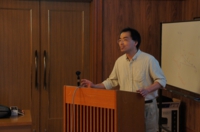
Federico Ricci-Tersenghi
"Making maximum entropy and linear response estimates consistent"
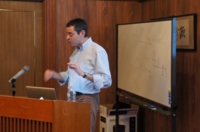
15:15-17:30 Session II
Tomoyuki Obuchi
"Partition-Function Zeros of Spin Glasses and Singularities in Quantum Quench Dynamics"
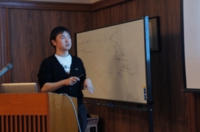
Tommaso Rizzo
"Replica Cluster Variational Method "
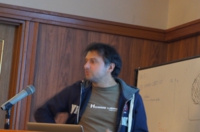
Shun Kataoka
"Gaussian graphical modeling for traffic density estimation"
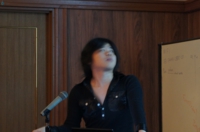
21 Marxh, 2013
10:00-12:15 Session 3
Takeshisa Hasegawa
"Classification of Phase Transitions in Complex Networks"
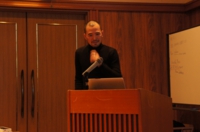
Ryuhei Mori
"New Generalization of the Bethe Approximation using Graph Covers"
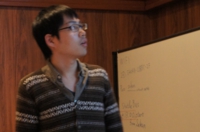
Masayuki Ohzeki
"Variational Principle in Statistical Mechanics"
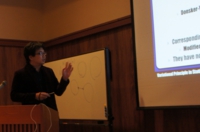
12:15-12:30 Closing Masayuki Ohzeki
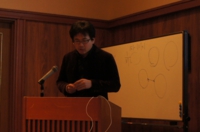
Epilogue Seminar Series of FSPIP2013
Even after the main conference, to keep in touch with each other of researchers in our realms, we discuss various topics through seminar series.
Date: 14:00- on 2013.07.16
Venue: Kyoto University, Research Bldg. No. 7 Seminar room 1 (127 on the ground floor)
Serzio Perez-Gaviro
Title: Overview through the Janus dedicated machine generation.
Abstract:
The Janus dedicated machine [1,2] was designed as a multipurpose reprogramable supercomputer some years ago. Its name arises from the two-faced ancient Roman God of Doors and Gates. It is based on a Field-Programmable-Gate-Array (FPGA) architecture, which permits researchers reprogram the computer's hardware connections structure.
During its life (it is around 5 years old), Janus has been focused on the study and simulation of spin glasses, paradigm of complex systems. Indeed has revealed as a very fruitful scientific machine for the study of spin glasses. We were able to reach simulation times up to 0.1 seconds of an experiment for large lattices and low temperatures. Several scientific works performed with Janus have been published in high impact scientific journals, as in the Proceedings of the National Academy of Science or in the Physical Review Letters.
Encouraged by the good results, the Janus Collaboration decided to go an step further developing and designing the new generation Janus dedicated computer, named JanusII. We expect to start the first massive JanusII campaign, devoted to spin glasses, by the end of August.
In addition, Janus is now open to other researchers out of the Janus Collaboration. New applications, as molecular dynamics, digital signal processing, cryptography or speech recognition among others, which can be fitted in a fpga architecture, will be very welcome!
References:
[1] F. Belletti et al., Computer Physics Communications 178 (3), p.208-216, (2008).
[2] F. Belletti et al., Computing in Science & Engineering 11-1, 48-58 (2009).
Epilogue Series of FSPIP2013
Italia-Giappone attraverso il futuro- A bridge across the future-
Even after the main conference, to keep in touch with each other of researchers in our realms, we continue to hold workshops in various cities in Japan.
The first workshop is held to make friendship with Italian researchers as ![]() "Italia-Giappone attraverso il futuro (A bridge across the future)".
"Italia-Giappone attraverso il futuro (A bridge across the future)".
Date: 2013.08.02
Venue: Kyoto University, Research Bldg. No. 7, Seminar Room No.2 (Ground floor)
Program
Opening Remarks: Masayuki Ohzeki (Kyoto University)
Kei Sano (Kyoto University)
Improved complex approximate message passing algorithm for Magnetic Resonance Imaging
Abstract: Compressed sensing is considered promising for reduction of acquisition time in Magnetic Resonance Imaging and spectroscopic imaging.
Development of effective methods to solve complex L1 minimization is desirable for applying compressed sensing to these applications. Here, we derive the modified version of complex approximate message passing algorithm.
Our proposed method is compatible with Fast Fourier Transform and Fast Wavelet Transform. In addition, we can obtain the index which how the reconstruction result is accurate based on the idea of State Evolution.
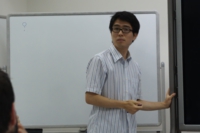
Kenta Nishimura (Kyoto University)
Finding sushi gourmet; Semi-supervised Subset Clustering for Extracting a Rare Cluster
Abstract: Thanks to many prosperous review sites, one can utilize such a service for the purpose of mining information.
In order to find a rare cluster from such a service we propose Semi-Supervised SubSet clustering (S4 clustering).
Using S4 clustering, we examine information about sushi gourmets from Tabelog, which is a review site about food service shops and provides rankings of restaurants based on reviews by users in Japan.
In order to mine information about sushi specialist we need to examine restaurants too because we think sushi specialists and the restaurants that they like have a good influence upon each other.
Therefore we use subset clustering, which separates users and restaurants simultaneously.
Furthermore the number of sushi gourmets and associated restaurants is very small since sushi has a aspect of “acquired taste” and sumptuous restaurants is thought to be awkward to go by many people. Overcoming
the difficulty of finding the rare cluster of sushi gourmets, we use a semi-supervised technique. We apply S4 clustering to the data of Tabelog and examine the result.
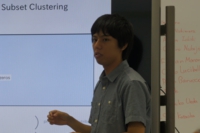
Akihisa Ichiki (Nagoya University)
Perspective beyond detailed balance from Markov chain Monte Carlo
Abstract: Markov chain Monte Carlo (MCMC) method conventionally imposes detailed balance condition.
However recent studies have witnessed that the absence of detailed balance accelerates the convergence in MCMC.
We show a systematic proof of the acceleration due to the detailed balance violation.
The real part of the second largest eigenvalue of the transition matrix always decreases by introduction of detailed balance breaking part into the transition matrix.
The result implies that the current induced in nonequilibrium system effectively boosts the transition between microstates.
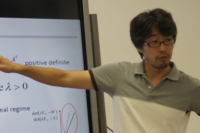
Lunch
Flaviano Morone (Sapienza Università di Roma)
Finite volume corrections in disordered diluted models
Abstract: Finite volume 1/N corrections in disordered systems on random graphs have a simple topological origin: they are represented as a weighted sum over finite closed loops of the network. The analytical prediction is very accurate in the spin-glass model above the AT line as well as in the paramagnetic phase of the random-field model. Below the AT line the finite size corrections for spin glasses are not proportional to 1/N , since the emergence of exponentially many states requires an extra-saddle point integration which alters the scaling factor 1/N.
Surprisingly the same phenomenon is also present in the random field model. As a consequence, in the ferromagnetic phase, the leading finite volume corrections are no longer of order O(1/N), but scale as 1/\sqrt{N}. In the replica picture the mechanism producing the anomalous scaling can be interpreted as the formation of bound states among replicas.
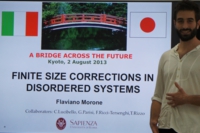
Carlo Lucibello (Sapienza Università di Roma)
Spectral representations of the replicated transfer matrix
Abstract: The replicated transfer matrix encodes many crucial properties of disordered models on fully-connected and diluted graphs. We present a formalism based on the irreducible representations of the replica symmetry group to express the transfer matrix in terms of left and right eigenvectors. In the replica symmetric phase we are able to provide easy to compute expressions for any type of two-point functions and for the free-energies of open and closed cavity chains. We also establish the equivalence between the eigenvectors and the distribution of cavity messages' perturbations.
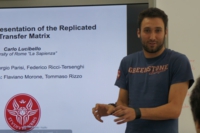
Paolo Barucca (Sapienza Università di Roma)
Quenched heterogeneities in spin systems
Abstract: We present a treatable generalization of the SK model which introduces correlation in the elements of the coupling matrix. We refer to this multiplicative disorder on the variables as quenched heterogeneity and investigate the consequences on the phase diagram. We define a generalized Edward-Anderson order parameter. We test the structural stability of the SK results in this correlated case evaluating the AT-line of the model and we demonstrate the increase of chaos in temperature effects in our weighted SK model, decreasing the required size for numerical observation of chaos in temperature.
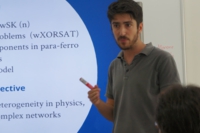
Shun Kataoka (Tohoku University)
Statistical-Mechanical Approaches for image in painting and segmentation filters
Abstract: Computer vision is one of the active research area in computer science.
Image inpainting and segmentation are examples of subjects of such area.
The image inpainting is a process to reconstruct missing parts of an image.
And the segmentation is a technique to divide an image into some different regions according to a certain criteria.
In this research, we propose two methods: the one is a parameter estimation method for Gaussian inpainting algorithm by using EM algorithm and message passing method.
The other is a new approach for image segmentation based on a fully connected Potts model.
We show the performances of both method numerically.
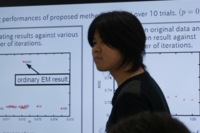
Masahiko Ueda (Kyoto University)
Estimation of 1RSB transition temperature of spin glass models on random graphs under replica symmetric ansatz
Abstract: Determining phase diagram of spin glass models on random graphs is important not only as preliminaries for finite dimensional models but also for the studies of combinatorial optimization problems.
For general models showing 1-step replica symmetry breaking(1RSB), the low temperature phase has been analyzed through the replica method with 1RSB ansatz or the 1RSB cavity method.
As a different approach, when fully connected models are concerned, the transition temperature to 1RSB phase can be calculated with a Franz-Parisi potential.
This method is practically useful because transition temperature is determined only with replica symmetric ansatz.
Thus, when this method can be applied to models on random graphs, the computational cost is substantially reduced.
In this research, we analyze spin glass models on regular random graphs via a Franz-Parisi potential.
As a result, we obtain reasonable values of the transition temperature under some approximation.
We also present the relation between this method and 1RSB calculations so far.
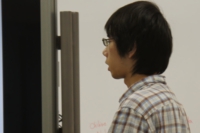
Chihiro Nakajima (Tohoku University)
Statistical Mechanical formulation and simulation of prime factorization of integers
Abstract: We propose a new approach to solve the problem of the prime factorization, formulating the problem as a ground state searching problem of statistical mechanics Hamiltonian.
The relationship between the computational complexity and the phase transition of the statistical mechanical model is discussed in several context; for example, the "replica symmetry breaking transition" of constraint satisfaction problems and the first order transition in quantum annealing algorithm.
Thus we expect to approach with using some property of the statistical mechanical model, although not limited to the phase transition.
We investigated the first passage time that the correct form of prime factorization is found and observed the behavior which seems to indicate exponential computational steps.
We talk about the interpretation of the above behavior and some future perspectives about how to describe the computational hardness of the prime factorization problem.
